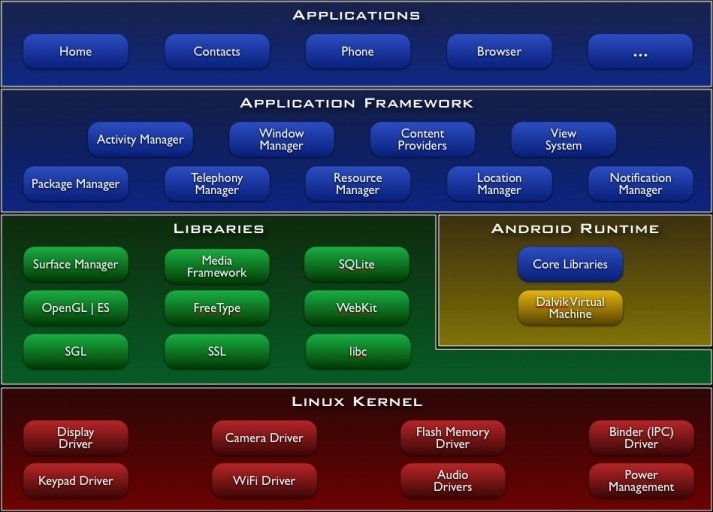Android Development 101

The Android Platform
-
A software stack for mobile devices
- OS kernel, system libraries, application
frameworks & key apps
- OS kernel, system libraries, application
-
Android SDK for creating apps
- Libraries & development tools

Linux Kernel
-
Standard Services
- Security, Memory & process management, File & network I/O, Device drivers
-
Android Specific
- Power management, Android shared memory, Low memory killer, Interprocess communication & More
Libraries
-
System C Library
-
Web Kit
-
Surface Manager
-
OpenGL
-
Media Framework
-
SQLite
Android Runtime
-
Core Java libraries
-
Dalvik Virtual Machine
Application Framework
-
Package Manager
-
Window Manager
-
View System
-
Resource Manager
-
Activity Manager
-
Content Provider
-
Location Manager
-
Notification Manager
Applications
- Home – main screen
- Contacts – contacts database
- Phone – dial phone numbers
- Browser – view web pages
- Email reader –compose & read email messages
- And more...
The Android Development Environment
- ADT Bundle
- Android Studio
- Android Emulator
- Debugger
- DDMS
Application Components
-
Activity
-
Service
-
Broadcastreceiver
-
Contentprovider
Activity
- Primary class for user interaction
- Usually implements a single, focused
task that the user can do
Service
- Runs in the background
- To perform long-running operations
- To support interaction with remote
processes
BroadcastReceiver
- Component that listens for and responds to
events - Events represented by the Intent class
and then Broadcast - BroadcastReceiver receives and
responds to broadcast event
Content Providers
- Store & share data across applications
- Uses database-style interface
- Handles interprocess communication

Creating An Android App
-
Define resources
-
Implement application classes
-
Package application
-
Install & run application
Defining Resources
-
Resources are non-source code entities
-
Many different resource types, such as
Layout, Strings, Images, Menus, & animations -
Allows apps to be customized for
different devices and users
Implement Classes
-
Usually involves at least one Activity
-
Activity initialization code usually resides in onCreate()
Package Application
-
System packages application components & resources into a .apk file
-
Developers specify required application information in a file called AndroidManifest.xml
Install & Run
-
From IDE run in the emulator or
device -
From command line (ADB)
Resources
Sumon M. Selim
Software Engineer, P1


@SumonMSelim